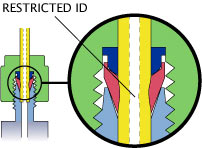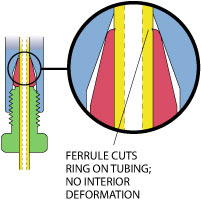The compression fitting, in which a one- or two-piece ferrule is compressed onto the tube as a nut is tightened, offers reliability in high pressure situations and in connecting metal tubing. Compression fittings which combine the nut and ferrule in a single unit are generally not as effective, since the sealing surface rotates as the tightening force is applied.

Valco excels in all critical areas of the design and manufacture of fittings. Quality considerations which cannot be ignored if an analytical system is to reach and maintain optimum performance levels include interchangeability, counterbore tolerances, ID/OD concentricity, mixing potential, cleaning procedures, and the method employed to "make up" the ferrule on the tube.
No tubing deformation

The basic concept of compression fittings carries the inherent danger of tube deformation, as illustrated in the upper drawing at right. While some manufacturers emphasize this positively as a method of ensuring that the tubing doesn't blow out of the ferrule, the flow anomalies introduced by the restricted ID make these fittings a poor choice for many instrument applications.

Valco metal ferrules cut a ring near the end of the tube (lower drawing), which prevents tube release at high pressures without significantly deforming and restricting the tube interior. Because our ferrules have a sharp edge at the ID near the nose, this usually takes only about 1/4 turn beyond the point where the ferrule first starts to grab the tubing. There is so little tube distortion that they are routinely used with glass-lined tubing!
Only Valco's polymer fittings rely on friction to hold a tube.



